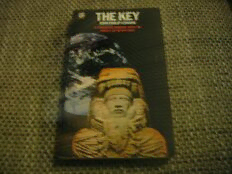Table Of ContentFONTANA
JOHN PHILIP COHANE
A STARTLING ENQUIRY INTO THE
RIDDLE OF MAN S PAST
John philip cohane was bom in New Haven,
Connecticut. After a successful career in advertising
in New York, he moved to County Limerick, where
he now devotes most of his time to writing. In
addition to The Key, he is the author of The
Indestructible Irish and has written for magazines,
the theatre and television. Mr Cohane is involved in
archaeological research with the Irish Government
and the University of Pennsylvania at several sites in
Ireland. When not ‘digging’ or writing, he spends as
much time as he can sailing and fox-hunting.
The Key
John Philip Cohane
Preface by Cyrus H. Gordon
Professor of Mediterranean Studies,
Brandeis University
FONTANA/COLLINS
First published in Great Britain by Turnstone Press Ltd 1971
First issued in Fontana 1975
Copyright © John Philip Cohane 1969, 1973
Set in Monotype Times Roman
Made and printed in Great Britain by
William Collins Sons & Co Ltd Glasgow
CONDITIONS OF SALE:
This book is sold subject to the condition that
it shall not, by way of trade or otherwise, be lent,
re-sold, hired out or otherwise circulated without
the publisher’s prior consent in any form of
binding or cover other than that in which it is
published and without a similar condition
including this condition being imposed on the
subsequent purchaser.
‘For as God was the help of our reason to illuminate
us, so should we likewise turn it every way, that we
may be more capable of understanding His mysteries;
provided only that the mind be enlarged, according
to its capacity, to the grandeur of the mysteries,
and not the mysteries contracted to the narrowness
of the mind.’ Francis Bacon
To four splendid Baconians:
Herman W. Liebert - Librarian, the Beinecke Rare
Book and Manuscript Library, Yale University
Dr Frederick L. Santee - Former Professor of Classics,
Kenyon College
Dr Professor Johannes Rahder (Retired) - Hall of
Graduate Studies, Yale University
David McDowell - Crown Publishers Inc.
and above all, to Rosalind Cole
Contents
List of Illustrations 8
Acknowledgements 9
Preface 11
The Key 15
Epilogue 190
Bibliography 201
Index 208
Illustrations
1 Naval Battle against the Libyans and the ‘Sea
People’, Temple of Medinet Habu, Egypt
2 Burial Chamber, New Grange, Ireland
3 Temple of Hal Tarxien, Malta
4 Monolithic stones at Avebury, England
5 Inca fortifications, Peru
6 ‘Stone of the Twelve Angels’, Haton Rumyoc, near
Cuzco, Peru
7 Mayan stele near Quirigu&, Guatemala
8 Pyramid of the Sun, Teotihuc&n, Mexico
Acknowledgements
I wish to express my gratitude to: J. Donald Rawlings, my
lawyer and old friend, who with his wife Eleanor patiently read
hundreds of pages of research and preliminary drafts of the
material; Admiral H B. Miller, USN (Ret.), who was an en
thusiast from the beginning; Charles J. Haughey, Minister for
Finance, Republic of Ireland, who on a score of occasions lent
his support and encouragement to the project; Doris Bryen, of
London, who brought together most of the photographs;
Warren Potter, of Crown Publishers, whose meticulous copy
editing contributed immeasurably to the accuracy of the text;
and to the staffs of the Bibliothdque Nationale, Paris; the British
Council Library, Rome; the British Museum Library, London;
the Jewish Museum Library, New York; the Library of Congress,
Washington, D.C.; the Limerick Public Library, Ireland; the
Museum of the American Indian, Heye Foundation Library, New
York; the National Library, Dublin; the New York Public
Library - with special thanks to Norwood Vail, First Assistant,
Map Division; the Royal Astronomical Society Library, London;
the Royal Hibernian Society Library, Dublin; the Royal Statisti
cal Society Library, London; the Trinity College Library,
Dublin; the Wiedener Library, Harvard University; and the
Yale University Library, Beinecke Rare Book and Manuscript
Library, New Haven.
And the whole world was of one language^
and of one speech. Genesis 11:1
Preface
There is abundant evidence pointing to nautical contacts between
the Old and New worlds going back to the Bronze Age. Exact
dates elude us, but by 1500 b.c. the process already had a long
history. By that time, one of the most important factors of
civilization on the world scene was the international and inter
continental network of merchant mariners. They were not com
posed of one ethnic group; but a dominant, if not the dominant,
element was Northwest Semitic, closely akin to the Phoenicians
in language, religion, and way of life. To those mariners we owe
much of our civilization, including the alphabet.
How they developed and spread civilization is illustrated by
the Bronze Age shipwreck excavated by George Bass at Geli-
donya off the coast of Turkey. The vessel, operating in the
Aegean with Minoan-Mycenaean cargo, was made of Syrian
wood, and its captain bore a Syrian seal. Thus the ship and its
leadership were from the Northwest Semitic sphere. On the ship
were the bronze tools of craftsmen, reflecting the fact that such
vessels moved not only merchandise but also carried the people
who actually practised the arts and crafts.
The metallurgy of pre-Columbian Mesoamerica belonged, not
to the Iron Age, but to the Bronze Age, showing that the techno
logical pattern had been set before the later Phoenicians, Greeks,
Romans and others appeared on the stage of history, let alone
reached America.
Mankind cherishes history but often lapses into collective
amnesia. The Egyptians forgot how to read their ancestors’
hieroglyphs; and the Persians lost their knowledge not only of
the script but also of the history and of the very names of Cyrus,
Cambyses and Xerxes who made their ancestors the rulers of the
world. The forgotten systems of writing had to be rediscovered,
and their messages revealed, through decipherment in the nine
teenth century. What seems strange is that Persian history had
been preserved in the ancient Greek and Hebrew classics un
beknown to the Persians themselves.
11

